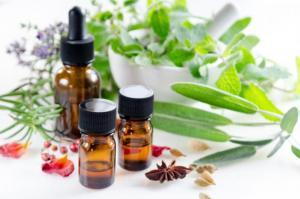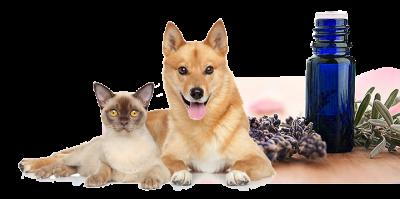Are Essential Oils Safe for my Pet? Part 1: Basics
- posted: Jan. 20, 2018
Are Essential Oils Safe for my Pet?
Part 1: Basics
By Dr. Christa Young, DVM - Bellalago Veterinary Hospital
[This is the first part of a multi-part series about essential oils. You can read Part 2: Usage here.]
 With people looking for more natural alternatives to help manage their health concerns and improve their quality of life, it makes sense for them to look for the same natural treatments for their pets.
With people looking for more natural alternatives to help manage their health concerns and improve their quality of life, it makes sense for them to look for the same natural treatments for their pets.
Recently there has been a Face Book post going viral claiming that essential oils kill pets and should never be used. The claims are not founded on any evidence or research and the misinformation does more harm than help. Being natural does NOT mean without any concern or consequence, but the appropriate essential oils used in the proper ways can be very safe and beneficial for dogs, cats, birds, rabbits, ferrets, guinea pigs, rats, mice, horses, and other companion animals.
What do you need to know to safely use essential oils for your pet?
- What is an essential oil?
- How to pick the right type and quality of the essential oil
- Correct ways to use or apply essential oils
- What signs to watch for indicating your pet is sensitive to essential oils
- Which oils are safe, toxic, or to be used with caution
- What to do if you suspect your pet has had a bad reaction to essential oils
- Where to find more information from a reliable resource
What is an essential oil?
Essential oils are purified oils made from particular parts of particular plants with therapeutic properties. Some oils are backed by research, while others have support from extensive experience of doctors and veterinarians.
Essential oils can help with many conditions and diseases, but they are not a cure-all and should be used under the direction of your veterinarian to help prevent any bad interactions with current medications or conditions that may be worsened by certain kinds of oils.
How do I pick a good essential oil?
 There are many, many brands of essential oils and they most definitely are not created equal. The biggest danger to your pet is if you pick a poor quality essential oil. Oils used as therapies for medical conditions MUST be therapeutic grade essential oils of the purest and highest quality. Do NOT use fragrance-grade or cheap essential oils!
There are many, many brands of essential oils and they most definitely are not created equal. The biggest danger to your pet is if you pick a poor quality essential oil. Oils used as therapies for medical conditions MUST be therapeutic grade essential oils of the purest and highest quality. Do NOT use fragrance-grade or cheap essential oils!
To complicate things, there are several species of a plant used for essential oils and not all of them are appropriate. For instance, there are 11 varieties of lavender available and many are synthetic. High-grade lavender does not have the flowery smell many human appreciate, but choosing a lower-grade option or Spike Lavender can be dangerous for your pet. Lavandula angustifolia derived from Australia is a safer variety.
Essential oils are also sold in two types – neat and ready-to-use formulations. First, we need to define a carrier oil. This is an oil that is used to dilute and carry the essential oils to where they are applied. Common carrier oils are fractionated coconut, vegetable, almond, jojoba, and hemp seed.
- Neat means the essential oils are undiluted and unmixed with a carrier oil.
- These are used with water diffusion, drinking water, and added to foods
- Ready-to-use means the essential oils are already diluted with a carrier oil
- These are applied directly to the skin or coat of your pet
- Some are mixed in a spray bottle and used to mist your pet
The three most reliable sources for therapeutic-grade essential oils I have found and use in my patients, myself, and my own pets are:
- Animal EO – created by a certified holistic veterinarian, Dr. Melissa Shelton
- Young Living essential oils – focused on people, but they have a section for pets
- DoTERRA essential oils – focused on people
These companies perform quality control testing on their products and offer support to those who purchase them.
If you have any questions, please feel free to reach out to us.
Our next installment of the series is forthcoming! Stay tuned!
Location
Find us on the map
Bellalago Veterinary Hospital
3809 Pleasant Hill Rd
Kissimmee, FL 34746, US

